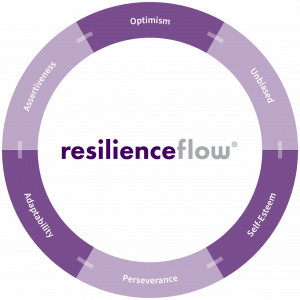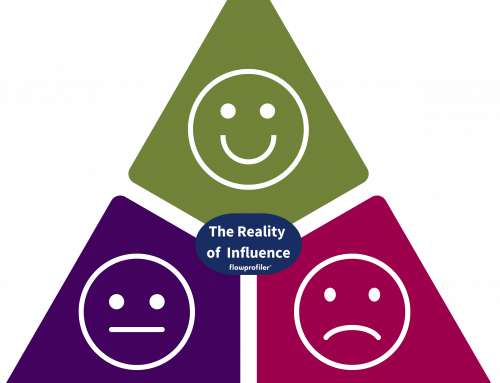Team resilience is crucial for success in today’s dynamic and challenging work environments. Resilient teams possess the ability to bounce back from setbacks, overcome obstacles, and adapt to change effectively. To build team resilience, it’s important to focus on various observable behaviours, such as optimism, assertiveness, adaptability, perseverance, self-esteem, and unbiased thinking.
possess the ability to bounce back from setbacks, overcome obstacles, and adapt to change effectively. To build team resilience, it’s important to focus on various observable behaviours, such as optimism, assertiveness, adaptability, perseverance, self-esteem, and unbiased thinking.
Here, we will explore 10 key elements that can help cultivate team resilience, drawing insights from various sources, including the flowprofiler® technical manual.
1.Optimism
Optimism plays a vital role in team resilience. Encourage team members to maintain a positive mindset, focusing on solutions rather than dwelling on problems. Optimistic individuals are more likely to view setbacks as temporary and believe in their ability to overcome challenges. By promoting optimism within your team, you can cultivate a resilient mindset that helps navigate difficulties effectively. (Source: Seligman, M. E. P. (2006). Learned Optimism. New York: Vintage Books.)
2. Assertiveness
Assertiveness allows team members to express their thoughts, ideas, and concerns effectively. Encouraging open communication and providing a safe space for sharing opinions enables team members to contribute to decision-making processes, address conflicts, and establish a collaborative environment. Assertive teams are better equipped to face challenges, adapt, and recover quickly. (Source: Randy J. Larsen, David M. Buss. (2014). Personality Psychology: Domains of Knowledge about Human Nature. McGraw-Hill Education.)
3. Adaptability
In rapidly changing work environments, adaptability is crucial for team resilience. Encourage team members to embrace change, learn new skills, and explore innovative approaches. Develop a culture that values flexibility, encourages experimentation, and supports continuous learning. By being adaptable, teams can effectively navigate uncertainties and thrive in dynamic situations. (Source: Boyatzis, R. E. (2008). Competencies in the 21st century. Journal of Management Development, 27(1), 5-12.)
4. Perseverance
Perseverance is the ability to persist in the face of challenges and setbacks. Encourage team members to develop a growth mindset and embrace failures as opportunities for learning and improvement. Recognize and celebrate small wins to maintain motivation and reinforce perseverance within the team. A resilient team understands that setbacks are temporary and uses them as stepping stones toward success. (Source: Duckworth, A. L. (2016). Grit: The Power of Passion and Perseverance. Scribner.)
5. Self-Esteem
Individuals with healthy self-esteem are more likely to exhibit resilience in the face of adversity. Encourage team members to recognize their strengths, celebrate achievements, and provide constructive feedback. Create a supportive environment where individuals feel valued and confident in their abilities. By nurturing self-esteem, teams can build a foundation for resilience and empower team members to overcome challenges. (Source: Rosenberg, M. (1965). Society and the Adolescent Self-Image. Princeton, NJ: Princeton University Press.)
6. Unbiased thinking
Unbiased thinking involves approaching situations without preconceived notions or prejudices. Encourage team members to challenge assumptions, seek diverse perspectives, and engage in critical thinking. Foster an inclusive environment that values diversity and encourages the expression of different ideas and opinions. Unbiased thinking enables teams to make better decisions, adapt to changing circumstances, and effectively address challenges. (Source: Stanovich, K. E. (2012). Rationality and the Unbiased Mind: A Rational Approach to Decision Making. Psychology Press.)
7. Problem solving
Building team resilience requires equipping team members with strong problem-solving skills. Encourage the development of analytical thinking, creativity, and the ability to identify and address root causes of challenges. Provide training and resources to enhance problem-solving abilities within the team. By empowering team members with robust problem-solving skills, you enable them to approach obstacles with confidence and find effective solutions. (Source: Dweck, C. S. (2006). Mindset: The New Psychology of Success. Random House.)
8. Growth mindset
A growth mindset is essential for building team resilience. Encourage team members to embrace challenges, see failures as opportunities for growth, and believe in their ability to learn and improve. Promote a culture that values continuous learning, provides development opportunities, and rewards effort and progress. By fostering a growth mindset, teams can adapt to changing circumstances, bounce back from setbacks, and continuously strive for excellence. (Source: Dweck, C. S. (2006). Mindset: The New Psychology of Success. Random House.)
9. Emotional intelligence
Emotional intelligence plays a significant role in team resilience. Encourage team members to develop self-awareness, empathy, and the ability to manage emotions effectively. Promote a culture that values emotional well-being and provides support during challenging times. By cultivating emotional intelligence, teams can navigate conflicts, maintain motivation, and build strong relationships that contribute to overall resilience. (Source: Goleman, D. (2005). Emotional Intelligence: Why It Can Matter More Than IQ. Bantam.)
10. Collaboration and team work
Resilient teams thrive on collaboration and teamwork. Encourage effective collaboration by promoting trust, fostering open communication, and establishing clear roles and responsibilities. Create opportunities for team members to work together, share knowledge, and support each other. By fostering a collaborative environment, teams can leverage diverse skills and perspectives to overcome challenges and enhance resilience. (Source: Katzenbach, J. R., & Smith, D. K. (2015). The Wisdom of Teams: Creating the High-Performance Organization. Harvard Business Review Press.)
Building team resilience requires a multifaceted approach, focusing on various dimensions such as optimism, assertiveness, adaptability, perseverance, self-esteem, and unbiased thinking. By incorporating these elements into your team’s culture, communication, and development initiatives, you can cultivate a resilient team that effectively faces challenges, adapts to change, and thrives in today’s dynamic work environments.

Remember to refer to sources and references for further in-depth insights and guidance, including the resilienceflow® assessment, flowprofiler® brochure, flowprofiler® YouTube channel, flowprofiler® technical manual and www.flowprofiler.com, all of which provide valuable information on various aspects of team resilience and individual dimensions.
Sources and references:
-
- Seligman, M. E. P. (2006). Learned Optimism. New York: Vintage Books.
- Randy J. Larsen, David M. Buss. (2014). Personality Psychology: Domains of Knowledge about Human Nature. McGraw-Hill Education.
- Boyatzis, R. E. (2008). Competencies in the 21st century. Journal of Management Development, 27(1), 5-12.
- Duckworth, A. L. (2016). Grit: The Power of Passion and Perseverance. Scribner.
- Rosenberg, M. (1965). Society and the Adolescent Self-Image. Princeton, NJ: Princeton University Press.
- Stanovich, K. E. (2012). Rationality and the Unbiased Mind: A Rational Approach to Decision Making. Psychology Press.
- Dweck, C. S. (2006). Mindset: The New Psychology of Success. Random House.
- Katzenbach, J. R., & Smith, D. K. (2015). The Wisdom of Teams: Creating the High-Performance Organization. Harvard Business Review Press.
- Goleman, D. (2005). Emotional Intelligence: Why It Can Matter More Than IQ. Bantam.



